
A | B | C | D | E | F | G | H | CH | I | J | K | L | M | N | O | P | Q | R | S | T | U | V | W | X | Y | Z | 0 | 1 | 2 | 3 | 4 | 5 | 6 | 7 | 8 | 9
| Part of a series on |
| Lutheranism |
|---|
 |
| Part of a series on |
| Protestantism |
|---|
 |
|
|
Lutheranism is a major branch of Protestantism, identifying primarily with the theology of Martin Luther, the 16th-century German monk and reformer whose efforts to reform the theology and practices of the Catholic Church launched the Protestant Reformation.[1]
The split between the Lutherans and the Roman Catholics was made public and clear with the 1521 Edict of Worms. The edicts of the Diet condemned Luther and officially banned citizens of the Holy Roman Empire from defending or propagating his ideas, subjecting advocates of Lutheranism to forfeiture of all property, half of the seized property to be forfeited to the imperial government and the remaining half forfeit to the party who brought the accusation.[2]
The divide centered primarily on two points: the proper source of authority in the church, often called the formal principle of the Reformation, and the doctrine of justification, often called the material principle of Lutheran theology.[a] Lutheranism advocates a doctrine of justification "by Grace alone through faith alone on the basis of Scripture alone," the doctrine that scripture is the final authority on all matters of faith. This is in contrast to the belief of the Roman Catholic Church, defined at the Council of Trent, concerning final authority coming from both the Scriptures and Tradition.[3]
Unlike Calvinism, Lutheranism retains many of the liturgical practices and sacramental teachings of the pre-Reformation Western Church, with a particular emphasis on the Eucharist, or Lord's Supper, though Eastern Lutheranism uses the Byzantine Rite.[4] Lutheran theology differs from Reformed theology in Christology, divine grace, the purpose of God's Law, the concept of perseverance of the saints, and predestination amongst other matters.
Etymology
The name Lutheran originated as a derogatory term used against Luther by German Scholastic theologian Johann Maier von Eck during the Leipzig Debate in July 1519.[5] Eck and other Roman Catholics followed the traditional practice of naming a heresy after its leader, thus labeling all who identified with the theology of Martin Luther as Lutherans.[2]
Martin Luther always disliked the term Lutheran, preferring the term evangelical, which was derived from εὐαγγέλιον euangelion, a Greek word meaning "good news", i.e. "Gospel".[5] The followers of John Calvin, Huldrych Zwingli, and other theologians linked to the Reformed tradition also used that term. To distinguish the two evangelical groups, others began to refer to the two groups as Evangelical Lutheran and Evangelical Reformed. As time passed by, the word Evangelical was dropped. Lutherans themselves began to use the term Lutheran in the middle of the 16th century, in order to distinguish themselves from other groups such as the Anabaptists and Calvinists.
In 1597, theologians in Wittenberg defined the title Lutheran as referring to the true church.[2]
History

Lutheranism has its roots in the work of Martin Luther, who sought to reform the Western Church to what he considered a more biblical foundation.[6][7] The reaction of the government and church authorities to the international spread of his writings, beginning with the Ninety-five Theses, divided Western Christianity.[8] During the Reformation, Lutheranism became the state religion of numerous states of northern Europe, especially in northern Germany, Scandinavia and the then-Livonian Order. Lutheran clergy became civil servants and the Lutheran churches became part of the state.[1]
Spread to Northern Europe

Lutheranism spread through all of Scandinavia during the 16th century as the monarchs of Denmark–Norway and Sweden adopted the faith. Through Baltic-German and Swedish rule, Lutheranism also spread into Estonia and Latvia. It also began spreading into Lithuania Proper with practically all members of the Lithuanian nobility converting to Lutheranism or Calvinism, but at the end of the 17th century Protestantism at large began losing support due to Counter-Reformation and religious persecutions.[9] In German-ruled Lithuania Minor, however, Lutheranism remained to be the dominant branch of Christianity.[10] Lutheranism played a crucial role in preserving the Lithuanian language.[11]
Since 1520, regular[12] Lutheran services have been held in Copenhagen. Under the reign of Frederick I (1523–33), Denmark–Norway remained officially Catholic. Although Frederick initially pledged to persecute Lutherans, he soon adopted a policy of protecting Lutheran preachers and reformers, the most significant of which was Hans Tausen.[13]
During Frederick's reign, Lutheranism made significant inroads in Denmark. At an open meeting in Copenhagen attended by King Christian III in 1536, the people shouted; "We will stand by the holy Gospel, and do not want such bishops anymore".[14] Frederick's son was openly Lutheran, which prevented his election to the throne upon his father's death in 1533. However, following his victory in the civil war that followed, in 1536 he became Christian III and advanced the Reformation in Denmark–Norway.
The constitution upon which the Danish Norwegian Church, according to the Church Ordinance, should rest was "The pure word of God, which is the Law and the Gospel".[15] It does not mention the[12] Augsburg Confession. The priests had to[12] understand the Holy Scripture well enough to preach and explain the Gospel and the Epistles to their congregations.
The youths were taught[16] from Luther's Small Catechism, available in Danish since 1532. They were taught to expect at the end of life:[12] "forgiving of their sins", "to be counted as just", and "the eternal life". Instruction is still similar.[17]
The first complete Bible in Danish was based on Martin Luther's translation into German. It was published in 1550 with 3,000 copies printed in the first edition; a second edition was published in 1589.[18] Unlike Catholicism, Lutheranism does not believe that tradition is a carrier of the "Word of God", or that only the communion of the Bishop of Rome has been entrusted to interpret the "Word of God".[12][19]
The Reformation in Sweden began with Olaus and Laurentius Petri, brothers who took the Reformation to Sweden after studying in Germany. They led Gustav Vasa, elected king in 1523, to Lutheranism. The pope's refusal to allow the replacement of an archbishop who had supported the invading forces opposing Gustav Vasa during the Stockholm Bloodbath led to the severing of any official connection between Sweden and the papacy in 1523.[13]
Four years later, at the Diet of Västerås, the king succeeded in forcing the diet to accept his dominion over the national church. The king was given possession of all church properties, as well as the church appointments and approval of the clergy. While this effectively granted official sanction to Lutheran ideas,[13] Lutheranism did not become official until 1593. At that time the Uppsala Synod declared Holy Scripture the sole guideline for faith, with four documents accepted as faithful and authoritative explanations of it: the Apostles' Creed, the Nicene Creed, the Athanasian Creed, and the unaltered Augsburg Confession of 1530.[20] Mikael Agricola's translation of the first Finnish New Testament was published in 1548.[21]
Counter-Reformation and controversies
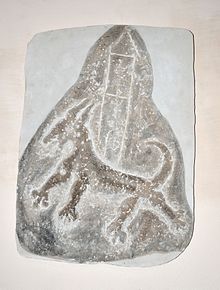
After the death of Martin Luther in 1546, the Schmalkaldic War started out as a conflict between two German Lutheran rulers in 1547. Soon, Holy Roman Imperial forces joined the battle and conquered the members of the Schmalkaldic League, oppressing and exiling many German Lutherans as they enforced the terms of the Augsburg Interim. Religious freedom in some areas was secured for Lutherans through the Peace of Passau in 1552, and under the legal principle of Cuius regio, eius religio (the religion of the ruler was to dictate the religion of those ruled) and the Declaratio Ferdinandei (limited religious tolerance) clauses of the Peace of Augsburg in 1555.[22]
Religious disputes between the Crypto-Calvinists, Philippists, Sacramentarians, Ubiquitarians and Gnesio-Lutherans raged within Lutheranism during the middle of the 16th century. This finally ended with the resolution of the issues in the Formula of Concord. Large numbers of politically and religiously influential leaders met together, debated, and resolved these topics on the basis of Scripture, resulting in the Formula, which over 8,000 leaders signed. The Book of Concord replaced earlier, incomplete collections of doctrine, unifying all German Lutherans with identical doctrine and beginning the period of Lutheran Orthodoxy.
In lands where Catholicism was the state religion, Lutheranism was officially illegal, although enforcement varied. Until the end of the Counter-Reformation, some Lutherans worshipped secretly, such as at the Hundskirke (which translates as dog church or dog altar), a triangle-shaped Communion rock in a ditch between crosses in Paternion, Austria. The crowned serpent is possibly an allusion to Ferdinand II, Holy Roman Emperor, while the dog possibly refers to Peter Canisius. Another figure interpreted as a snail carrying a church tower is possibly a metaphor for the Protestant church. Also on the rock is the number 1599 and a phrase translating as "thus gets in the world".[23]
Lutheran orthodoxy
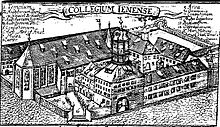

The historical period of Lutheran Orthodoxy is divided into three sections: Early Orthodoxy (1580–1600), High Orthodoxy (1600–1685), and Late Orthodoxy (1685–1730). Lutheran scholasticism developed gradually, especially for the purpose of arguing with the Jesuits, and it was finally established by Johann Gerhard. Abraham Calovius represents the climax of the scholastic paradigm in orthodox Lutheranism. Other orthodox Lutheran theologians include Martin Chemnitz, Aegidius Hunnius, Leonhard Hutter, Nicolaus Hunnius, Jesper Rasmussen Brochmand, Salomo Glassius, Johann Hülsemann, Johann Conrad Dannhauer, Johannes Andreas Quenstedt, Johann Friedrich König, and Johann Wilhelm Baier.
Near the end of the Thirty Years' War, the compromising spirit seen in Philip Melanchthon rose up again in Helmstedt School and especially in theology of Georgius Calixtus, causing the syncretistic controversy. Another theological issue that arose was the Crypto-Kenotic controversy.[24]
Late orthodoxy was torn by influences from rationalism, philosophy based on reason, and Pietism, a revival movement in Lutheranism. After a century of vitality, the Pietist theologians Philipp Jakob Spener and August Hermann Francke warned that orthodoxy had degenerated into meaningless intellectualism and formalism, while orthodox theologians found the emotional and subjective focuses of Pietism to be vulnerable to Rationalist propaganda.[25] In 1688, the Finnish Radical Pietist Lars Ulstadius ran down the main aisle of Turku Cathedral naked while screaming that the disgrace of Finnish clergymen would be revealed like his current disgrace.
The last famous orthodox Lutheran theologian before the rationalist Aufklärung, or Enlightenment, was David Hollatz. Late orthodox theologian Valentin Ernst Löscher took part in the controversy against Pietism. Medieval mystical traditions continued in the works of Martin Moller, Johann Arndt, and Joachim Lütkemann. Pietism became a rival of orthodoxy but adopted some devotional literature by orthodox theologians, including Arndt, Christian Scriver and Stephan Prätorius.
Rationalism
Rationalist philosophers from France and England had an enormous impact during the 18th century, along with the German Rationalists Christian Wolff, Gottfried Leibniz, and Immanuel Kant. Their work led to an increase in rationalist beliefs, "at the expense of faith in God and agreement with the Bible".[25]
In 1709, Valentin Ernst Löscher warned that this new Rationalist view of the world fundamentally changed society by drawing into question every aspect of theology. Instead of considering the authority of divine revelation, he explained, Rationalists relied solely on their personal understanding when searching for truth.[26]
Johann Melchior Goeze (1717–1786), pastor of St. Catherine's Church, Hamburg, wrote apologetical works against Rationalists, including a theological and historical defence against the historical criticism of the Bible.[27]
Dissenting Lutheran pastors were often reprimanded by the government bureaucracy overseeing them, for example, when they tried to correct Rationalist influences in the parish school.[28] As a result of the impact of a local form of rationalism, termed Neology, by the latter half of the 18th century, genuine piety was found almost solely in small Pietist conventicles.[25] However, some of the laity preserved Lutheran orthodoxy from both Pietism and rationalism through reusing old catechisms, hymnbooks, postils, and devotional writings, including those written by Johann Gerhard, Heinrich Müller and Christian Scriver.[29]
Revivals
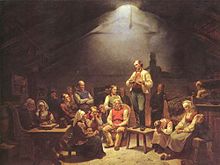
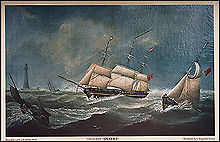
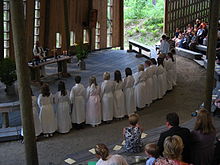
Luther scholar Johann Georg Hamann (1730–1788), a layman, became famous for countering Rationalism and striving to advance a revival known as the Erweckung, or Awakening.[30] In 1806, Napoleon's invasion of Germany promoted Rationalism and angered German Lutherans, stirring up a desire among the people to preserve Luther's theology from the Rationalist threat. Those associated with this Awakening held that reason was insufficient and pointed out the importance of emotional religious experiences.[31][32]
Small groups sprang up, often in universities, which devoted themselves to Bible study, reading devotional writings, and revival meetings. Although the beginning of this Awakening tended heavily toward Romanticism, patriotism, and experience, the emphasis of the Awakening shifted around 1830 to restoring the traditional liturgy, doctrine, and confessions of Lutheranism in the Neo-Lutheran movement.[31][32]
This Awakening swept through all of Scandinavia except Iceland.[33] It developed from both German Neo-Lutheranism and Pietism. Danish pastor and philosopher N. F. S. Grundtvig reshaped church life throughout Denmark through a reform movement beginning in 1830. He also wrote about 1,500 hymns, including God's Word Is Our Great Heritage.[34]
In Norway, Hans Nielsen Hauge, a lay street preacher, emphasized spiritual discipline and sparked the Haugean movement,[35] which was followed by the Johnsonian Awakening within the state-church.[36] The Awakening drove the growth of foreign missions in Norway to non-Christians to a new height, which has never been reached since.[33] In Sweden, Lars Levi Læstadius began the Laestadian movement that emphasized moral reform.[35] In Finland, a farmer, Paavo Ruotsalainen, began the Finnish Awakening when he took to preaching about repentance and prayer.[35]
In 1817, Frederick William III of Prussia ordered the Lutheran and Reformed churches in his territory to unite, forming the Prussian Union of Churches. The unification of the two branches of German Protestantism sparked the Schism of the Old Lutherans. Many Lutherans, called "Old Lutherans", chose to leave the state churches despite imprisonment and military force.[30] Some formed independent church bodies, or "free churches", at home while others left for the United States, Canada and Australia. A similar legislated merger in Silesia prompted thousands to join the Old Lutheran movement. The dispute over ecumenism overshadowed other controversies within German Lutheranism.[37]
Despite political meddling in church life, local and national leaders sought to restore and renew Christianity. Neo-Lutheran Johann Konrad Wilhelm Löhe and Old Lutheran free church leader Friedrich August Brünn[38] both sent young men overseas to serve as pastors to German Americans, while the Inner Mission focused on renewing the situation home.[39] Johann Gottfried Herder, superintendent at Weimar and part of the Inner Mission movement, joined with the Romantic movement with his quest to preserve human emotion and experience from Rationalism.[40]
Ernst Wilhelm Hengstenberg, though raised Reformed, became convinced of the truth of historic Lutheranism as a young man.[41] He led the Neo-Lutheran Repristination School of theology, which advocated a return to the orthodox theologians of the 17th century and opposed modern Bible scholarship.[42][better source needed] As editor of the periodical Evangelische Kirchenzeitung, he developed it into a major support of Neo-Lutheran revival and used it to attack all forms of theological liberalism and rationalism. Although he received a large amount of slander and ridicule during his forty years at the head of revival, he never gave up his positions.[41]
The theological faculty at the University of Erlangen in Bavaria became another force for reform.[41] There, professor Adolf von Harless, though previously an adherent of rationalism and German idealism, made Erlangen a magnet for revival oriented theologians.[43] Termed the Erlangen School of theology, they developed a new version of the Incarnation,[43] which they felt emphasized the humanity of Jesus better than the ecumenical creeds.[44] As theologians, they used both modern historical critical and Hegelian philosophical methods instead of attempting to revive the orthodoxy of the 17th century.[45]
Friedrich Julius Stahl led the High Church Lutherans. Though raised Jewish, he was baptized as a Christian at the age of 19 through the influence of the Lutheran school he attended. As the leader of a neofeudal Prussian political party, he campaigned for the divine right of kings, the power of the nobility, and episcopal polity for the church. Along with Theodor Kliefoth and August Friedrich Christian Vilmar, he promoted agreement with the Roman Catholic Church with regard to the authority of the institutional church, ex opere operato effectiveness of the sacraments, and the divine authority of clergy. Unlike Catholics, however, they also urged complete agreement with the Book of Concord.[44]
The Neo-Lutheran movement managed to slow secularism and counter atheistic Marxism, but it did not fully succeed in Europe.[39] It partly succeeded in continuing the Pietist movement's drive to right social wrongs and focus on individual conversion. The Neo-Lutheran call to renewal failed to achieve widespread popular acceptance because it both began and continued with a lofty, idealistic Romanticism that did not connect with an increasingly industrialized and secularized Europe.[46] The work of local leaders resulted in specific areas of vibrant spiritual renewal, but people in Lutheran areas became increasingly distant from church life.[39] Additionally, the revival movements were divided by philosophical traditions. The Repristination school and Old Lutherans tended towards Kantianism, while the Erlangen school promoted a conservative Hegelian perspective. By 1969, Manfried Kober complained that "unbelief is rampant" even within German Lutheran parishes.[47]
Doctrine
Bible

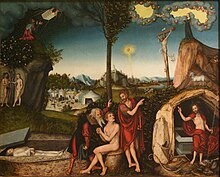
Traditionally, Lutherans hold the Scriptures of the Old and New Testaments to be the only divinely inspired books, the only presently available sources of divinely revealed knowledge, and the only infallible source of Christian doctrine.[48] Scripture alone is the formal principle of the faith, the final authority for all matters of faith and morals because of its inspiration, authority, clarity, efficacy, and sufficiency.[49]
The authority of the Scriptures has been challenged during the history of Lutheranism. Martin Luther taught that the Bible was the written Word of God, and the only infallible guide for faith and practice. He held that every passage of Scripture has one straightforward meaning, the literal sense as interpreted by other Scripture.[50] These teachings were accepted during the orthodox Lutheranism of the 17th century.[51] During the 18th century, Rationalism advocated reason rather than the authority of the Bible as the final source of knowledge, but most of the laity did not accept this Rationalist position.[52] In the 19th century, a confessional revival re-emphasized the authority of the Scriptures and agreement with the Lutheran Confessions.
Today, Lutherans disagree about the inspiration and authority of the Bible. Theological conservatives use the historical-grammatical method of Biblical interpretation, while theological liberals use the higher critical method. The 2008 U.S. Religious Landscape Survey conducted by the Pew Research Center surveyed 1,926 adults in the United States that self-identified as Lutheran. The study found that 30% believed that the Bible was the Word of God and was to be taken literally word for word. 40% held that the Bible was the Word of God, but was not literally true word for word or were unsure. 23% said the Bible was written by men and not the Word of God. 7% did not know, were not sure, or had other positions.[53]
Inspiration
Although many Lutherans today hold less specific views of inspiration, historically, Lutherans affirm that the Bible does not merely contain the Word of God, but every word of it is, because of plenary, verbal inspiration, the direct, immediate word of God.[54] The Apology of the Augsburg Confession identifies Holy Scripture with the Word of God[55] and calls the Holy Spirit the author of the Bible.[56] Because of this, Lutherans confess in the Formula of Concord, "we receive and embrace with our whole heart the prophetic and apostolic Scriptures of the Old and New Testaments as the pure, clear fountain of Israel".[57] The prophetic and apostolic Scriptures are confessed as authentic and written by the prophets and apostles. A correct translation of their writings is seen as God's Word because it has the same meaning as the original Hebrew and Greek.[58] A mistranslation is not God's word, and no human authority can invest it with divine authority.[58]
Clarity
Historically, Lutherans understand the Bible to present all doctrines and commands of the Christian faith clearly.[59] In addition, Lutherans believe that God's Word is freely accessible to every reader or hearer of ordinary intelligence, without requiring any special education.[60] A Lutheran must understand the language that scriptures are presented in, and should not be so preoccupied by error so as to prevent understanding.[61] As a result of this, Lutherans do not believe there is a need to wait for any clergy, pope, scholar, or ecumenical council to explain the real meaning of any part of the Bible.[62]
Efficacy
Lutherans confess that Scripture is united with the power of the Holy Spirit and with it, not only demands, but also creates the acceptance of its teaching.[63] This teaching produces faith and obedience. Holy Scripture is not a dead letter, but rather, the power of the Holy Spirit is inherent in it.[64] Scripture does not compel a mere intellectual assent to its doctrine, resting on logical argumentation, but rather it creates the living agreement of faith.[65] As the Smalcald Articles affirm, "in those things which concern the spoken, outward Word, we must firmly hold that God grants His Spirit or grace to no one, except through or with the preceding outward Word".[66]
Sufficiency

Lutherans are confident that the Bible contains everything that one needs to know in order to obtain salvation and to live a Christian life.[67] There are no deficiencies in Scripture that need to be filled with by tradition, pronouncements of the Pope, new revelations, or present-day development of doctrine.[68]
Law and Gospel
Lutherans understand the Bible as containing two distinct types of content, termed Law and Gospel (or Law and Promises).[69] Properly distinguishing between Law and Gospel prevents the obscuring of the Gospel teaching of justification by grace through faith alone.[70]
Lutheran confessions

The Book of Concord, published in 1580, contains 10 documents which some Lutherans believe are faithful and authoritative explanations of Holy Scripture. Besides the three Ecumenical Creeds, which date to Roman times, the Book of Concord contains seven credal documents articulating Lutheran theology in the Reformation era.
The doctrinal positions of Lutheran churches are not uniform because the Book of Concord does not hold the same position in all Lutheran churches. For example, the state churches in Scandinavia consider only the Augsburg Confession as a "summary of the faith" in addition to the three ecumenical creeds.[71] Lutheran pastors, congregations, and church bodies in Germany and the Americas usually agree to teach in harmony with the entire Lutheran confessions. Some Lutheran church bodies require this pledge to be unconditional because they believe the confessions correctly state what the Bible teaches. Others allow their congregations to do so "insofar as" the confessions are in agreement with the Bible. In addition, Lutherans accept the teachings of the first seven ecumenical councils of the Christian Church.[72][73]
The Lutheran Church traditionally sees itself as the "main trunk of the historical Christian Tree" founded by Christ and the Apostles, holding that during the Reformation, the Church of Rome fell away.[74][75] As such, the Augsburg Confession teaches that "the faith as confessed by Luther and his followers is nothing new, but the true catholic faith, and that their churches represent the true catholic or universal church".[76] When the Lutherans presented the Augsburg Confession to Charles V, Holy Roman Emperor, they explained "that each article of faith and practice was true first of all to Holy Scripture, and then also to the teaching of the church fathers and the councils".[76]
Justification

The key doctrine, or material principle, of Lutheranism is the doctrine of justification. Lutherans believe that humans are saved from their sins by God's grace alone (Sola Gratia), through faith alone (Sola Fide), on the basis of Scripture alone (Sola Scriptura). Orthodox Lutheran theology holds that God made the world, including humanity, perfect, holy and sinless. However, Adam and Eve chose to disobey God, trusting in their own strength, knowledge, and wisdom.[77][78] Consequently, people are saddled with original sin, born sinful and unable to avoid committing sinful acts.[79] For Lutherans, original sin is the "chief sin, a root and fountainhead of all actual sins".[80]
Lutherans teach that sinners, while capable of doing works that are outwardly "good", are not capable of doing works that satisfy God's justice.[81] Every human thought and deed is infected with sin and sinful motives.[82] Because of this, all humanity deserves eternal damnation in hell.[83] God in eternity has turned His Fatherly heart to this world and planned for its redemption because he loves all people and does not want anyone to be eternally damned.[84]
To this end, "God sent his Son Jesus Christ, our Lord, into the world to redeem and deliver us from the power of the devil, and to bring us to Himself, and to govern us as a King of righteousness, life, and salvation against sin, death, and an evil conscience", as Luther's Large Catechism explains.[85] Because of this, Lutherans teach that salvation is possible only because of the grace of God made manifest in the birth, life, suffering, death, resurrection, and continuing presence by the power of the Holy Spirit, of Jesus Christ.[86] By God's grace, made known and effective in the person and work of Jesus Christ, a person is forgiven, adopted as a child and heir of God, and given eternal salvation.[87] Christ, because he was entirely obedient to the law with respect to both his human and divine natures, "is a perfect satisfaction and reconciliation of the human race", as the Formula of Concord asserts, and proceeds to summarize:[88]
submitted to the law for us, bore our sin, and in going to his Father performed complete and perfect obedience for us poor sinners, from his holy birth to his death. Thereby he covered all our disobedience, which is embedded in our nature and in its thoughts, words, and deeds, so that this disobedience is not reckoned to us as condemnation but is pardoned and forgiven by sheer grace, because of Christ alone.
Lutherans believe that individuals receive this gift of salvation through faith alone.[89] Saving faith is the knowledge of,[90] acceptance of,[91] and trust[92] in the promise of the Gospel.[93] Even faith itself is seen as a gift of God, created in the hearts of Christians[94] by the work of the Holy Spirit through the Word[95] and Baptism.[96] Faith receives the gift of salvation rather than causes salvation.[97] Thus, Lutherans reject the "decision theology" which is common among modern evangelicals.
Since the term "grace" has been defined differently by other Christian church bodies.[98] Lutheranism defines grace as entirely limited to God's gifts to us, which is bestowed as pure gift, not something we merit by behavior or acts. To Lutherans, grace is not about our response to God's gifts, but only His gifts.
Trinity

Lutherans believe in the Trinity, rejecting the idea that the Father and God the Son are merely faces of the same person, stating that both the Old Testament and the New Testament show them to be two distinct persons.[99] Lutherans believe the Holy Spirit proceeds from both the Father and the Son.[100] In the words of the Athanasian Creed: "We worship one God in Trinity, and Trinity in Unity; Neither confounding the Persons, nor dividing the Substance. For there is one Person of the Father, another of the Son, and another of the Holy Ghost. But the Godhead of the Father, of the Son, and of the Holy Ghost is all one: the glory equal, the majesty coeternal."[101]
Two natures of Christ
Lutherans believe Jesus is the Christ, the savior promised in the Old Testament. They believe he is both by nature God and by nature man in one person, as they confess in Luther's Small Catechism that he is "true God begotten of the Father from eternity and also true man born of the Virgin Mary".[102]
Zdroj:https://en.wikipedia.org?pojem=Lutheranism
Text je dostupný za podmienok Creative Commons Attribution/Share-Alike License 3.0 Unported; prípadne za ďalších podmienok. Podrobnejšie informácie nájdete na stránke Podmienky použitia.
Antropológia
Aplikované vedy
Bibliometria
Dejiny vedy
Encyklopédie
Filozofia vedy
Forenzné vedy
Humanitné vedy
Knižničná veda
Kryogenika
Kryptológia
Kulturológia
Literárna veda
Medzidisciplinárne oblasti
Metódy kvantitatívnej analýzy
Metavedy
Metodika
Text je dostupný za podmienok Creative
Commons Attribution/Share-Alike License 3.0 Unported; prípadne za ďalších
podmienok.
Podrobnejšie informácie nájdete na stránke Podmienky
použitia.
www.astronomia.sk | www.biologia.sk | www.botanika.sk | www.dejiny.sk | www.economy.sk | www.elektrotechnika.sk | www.estetika.sk | www.farmakologia.sk | www.filozofia.sk | Fyzika | www.futurologia.sk | www.genetika.sk | www.chemia.sk | www.lingvistika.sk | www.politologia.sk | www.psychologia.sk | www.sexuologia.sk | www.sociologia.sk | www.veda.sk I www.zoologia.sk
